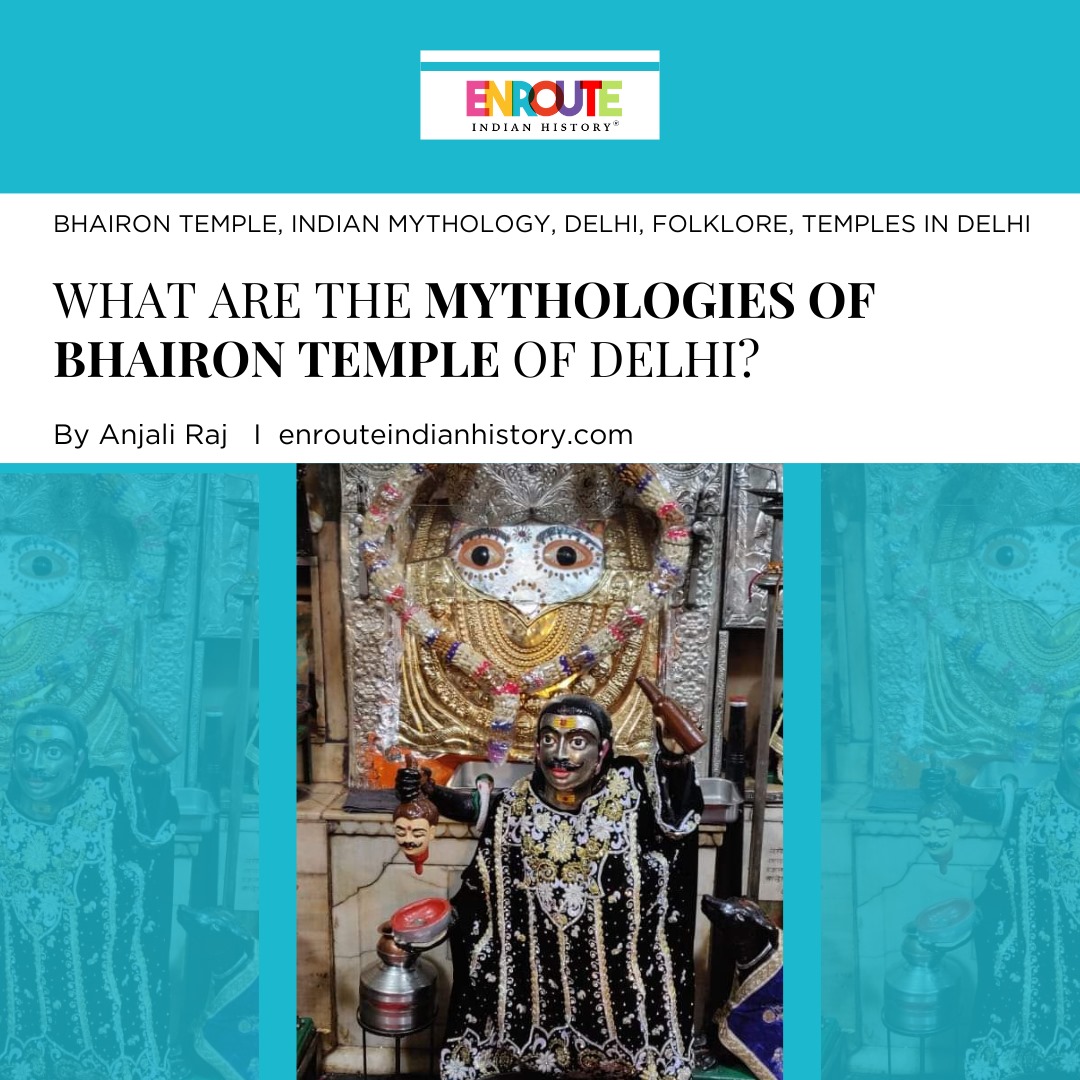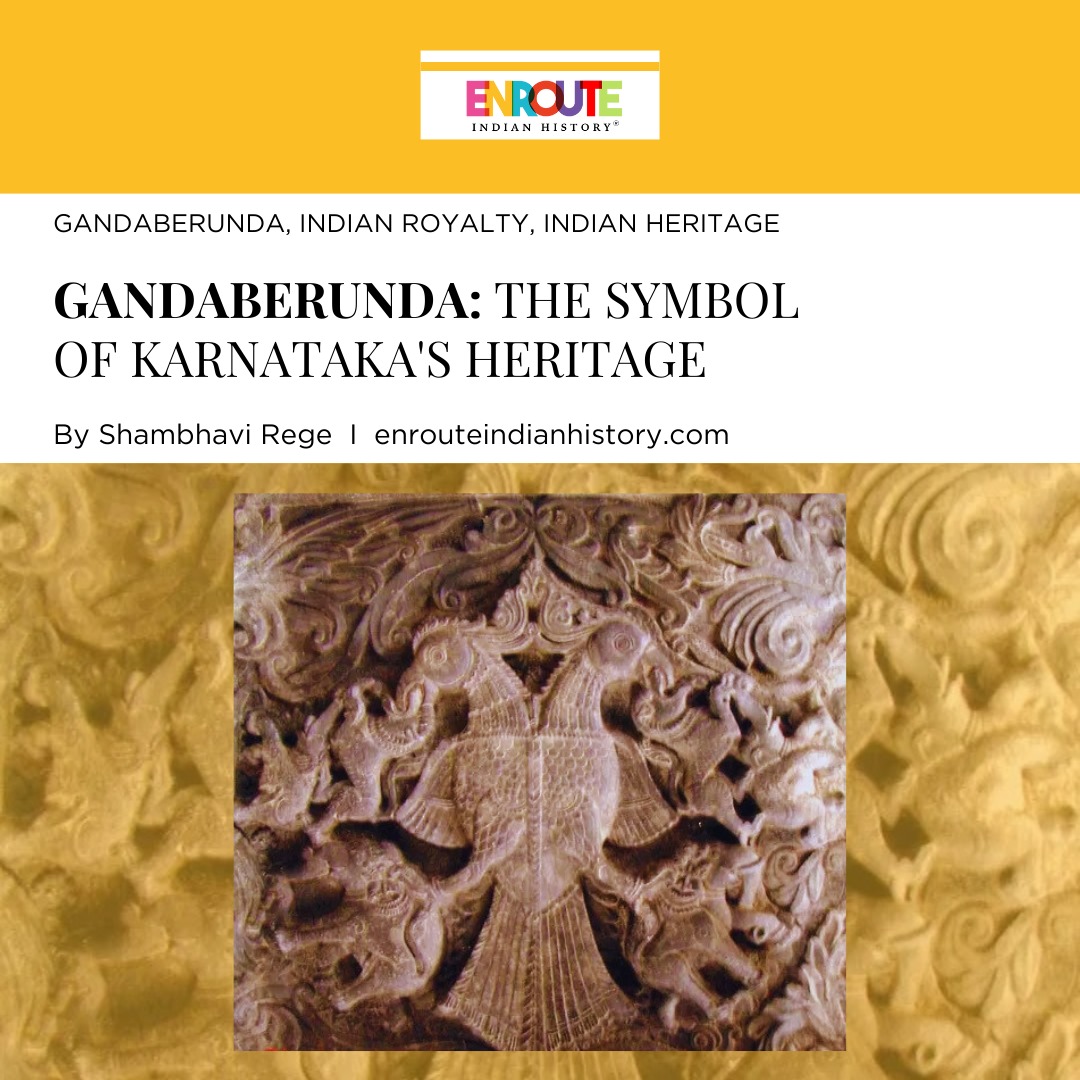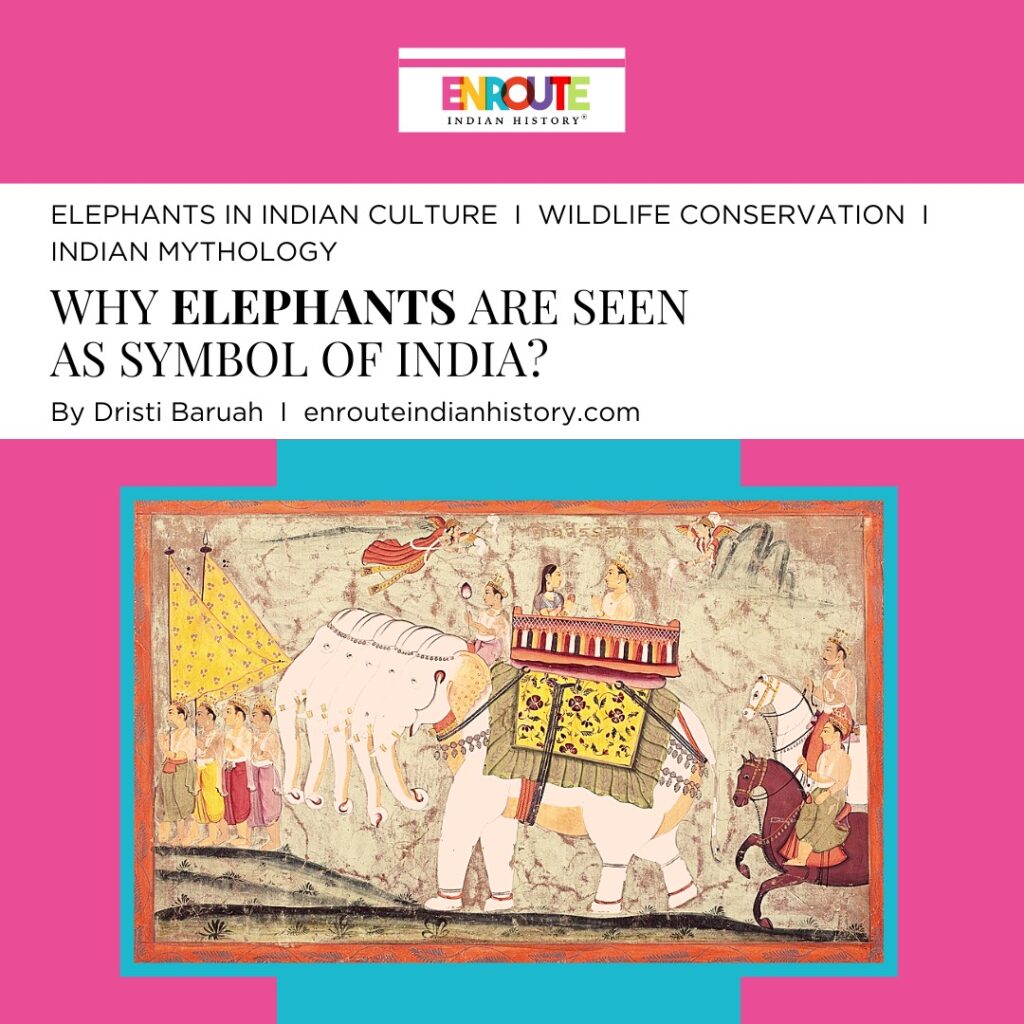
In Indian art, philosophy, and religion, elephants are revered as sacred symbols. In Indian symbolism, an elephant essentially represents strength and fertility. Elephants have a number of analogies that highlight their qualities as important religious creatures.
From a Vedic mythological perspective, it represents Lord Indra, who is also associated with fertility as he is the rain god. He rides the celestial white coloured elephant named “Airavat”. As Indra’s vehicle, Airavata represents the creation and motion of clouds in the sky.

Indra (alias Sakra) and Shachi riding the five-headed Divine Elephant Airavata, Folio from a Jain text, Panch Kalyanaka (Five Auspicious Events in the Life of Jina Rishabhanatha), c. 1670–1680, Painting in LACMA museum, originally from Amber, Rajasthan
One mythological tale claims that Airavata is Iraa’s son. Who is Iraa? The feminine side of reproduction is called Iraa, referring to a procreative whitish fluid that is the potential for both conception and life. As such, Airavata, son of Iraa, represents the life elements infused in water. Another tale claims that Airavata was born when the god Brahma sang seven holy songs over the two halves of the egg shell that Garuda had hatched. Eight elephants, including Airavata, emerged from the right, and eight female elephants emerged from the left. The sixteen were the ancestors of all elephants on Earth as well as those in heaven. They also evolved into “Dig Gajas”, who watched over space and represented the guardian deities ruling the eight points of the universe—four cardinal directions and four intermediate directions.
In Puranic Hinduism, the elephant is associated with Lord Ganesha, the remover of obstacles and the god of wisdom. Ganesha is one of the most revered deities in the Hindu pantheon, making the elephant a symbol of auspicious beginnings and good fortune.
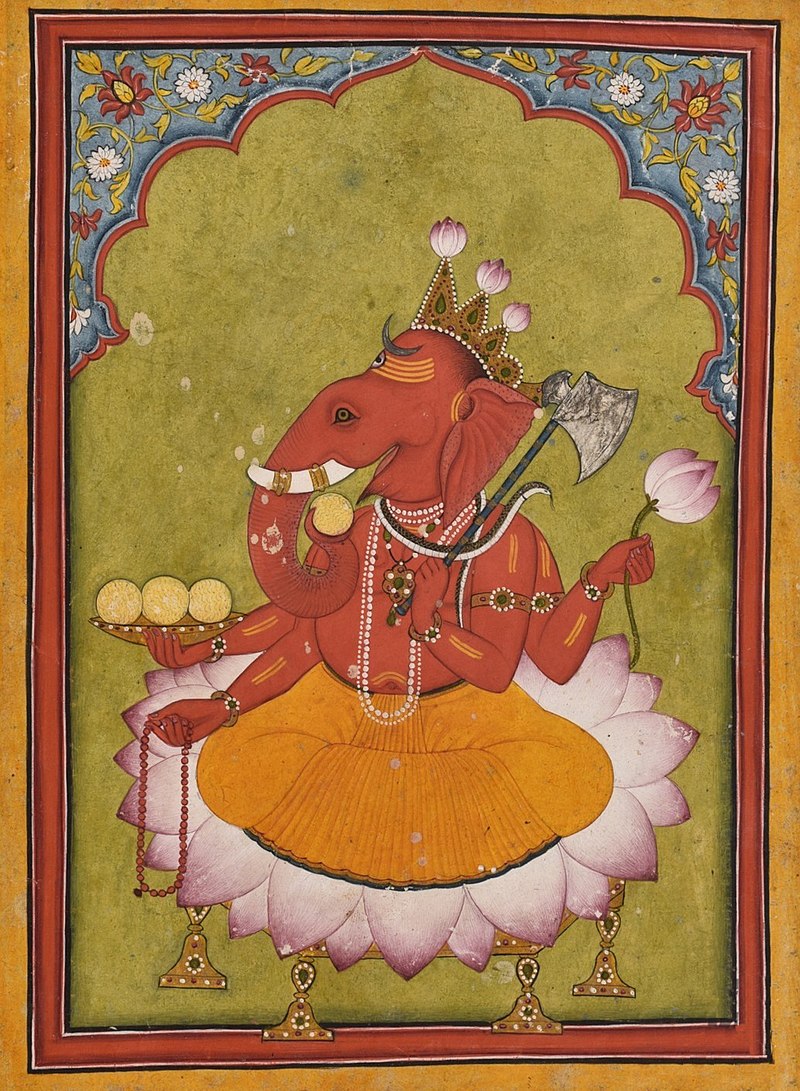
Ganesha getting ready to throw his lotus in a Basohli miniature.
One of the most exquisite sculptural themes found in rock-cut and temple construction is the hybrid of a lion and elephant. The most common names for it are “Gaja Simha”, “Gaja Vyāla”, “Gaja Viāla” and “Gaja Śardula”. In his description of the theme, C. Sivaramamurti notes that the motif was a popular subject in mediaeval art from Northeast India. He also mentions its existence on the Buddha’s seat in Java, near Chadi Mendut.
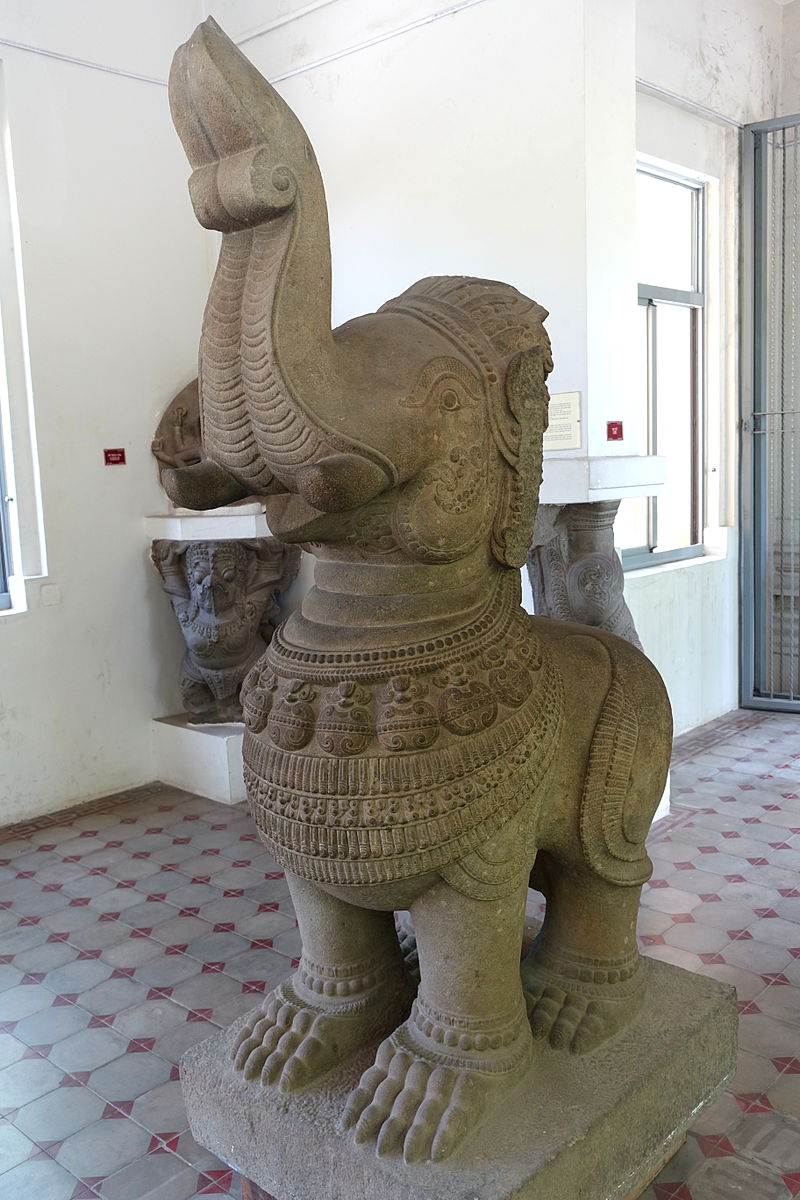
Gajasimha sculpture, Museum of Cham Sculpture, Danang, Vietnam
The elephant is also associated with the image of Laksmi, the goddess of wealth and prosperity, and the combined image of “Gaja Lakshmi” appears in a number of sculptures and engravings from a wide range of ancient and medieval temples. The Gaja-Lakshmi imagery in which two elephants flank water on Lakshmi (also known as Sri) in one of the most widely recognised and conventional representations of her. For the regal power to be established and reaffirmed, this act of abhishekam done on Lakshmi is essential. Since elephants served as the heavy artillery for ancient Indian kings’ stables during military excursions, elephants are also symbolic of royal authority. Kings were tightly linked to regal authority and frequently rode on elephants in ceremonial processions. In ancient India, kings were held accountable for agricultural fertility and rainfall. A monarch should regard it as the highest of his obligations to recover land for farming, fertilise it, and safeguard his subjects, as texts such as the Mahabharata instruct. It’s possible that in order to guarantee their positive influence, the monarchs found it necessary to keep a number of elephants as a symbol of their might and ability to provide rain that would fertilise their land.
Elephants had immense political significance in addition to their religious significance. For example we can take the importance assigned to the animal by the foreigner Greeks who came to rule in the northwest of the subcontinent. Seleucus I gave the Indian emperor Chandragupta Maurya various provinces in the Northwest in return for a herd of 500 war elephants and handlers. Over the following century, these giant animals and their offspring participated in the conflicts of his several successors. Elephants are an easily understood emblem of strength and power and are also associated with India. The Greeks were captivated by this enormous and majestic animal to such an extent that it appeared on their coins. A few monarchs even wore an elephant headdress on their portrait coins to symbolise their conquest of Indian lands.

The reverse of the coin of Graeco Indian king Antialkidas shows Zeus with lotus-tipped sceptre, in front of an elephant with a bell (symbol of Taxila), surmounted by Nike holding a wreath, crowning the elephant.
The elephant was a major artistic motif in early Buddhist art as well. The Buddha’s birth narrative explains why the elephant is accepted as a symbol of life energy and childbirth in the Buddhist canon. This is connected to Lord Buddha’s mother, Mahamaya’s dream of the white elephant (perhaps Airavata) entering her womb. Festivals honouring elephants were observed in the past. Buddhist jataka stories such as “Mati posaka jataka” and “Susim jataka” refer to them as “Hastimangal“. The elephant is also the vahana of the second jina, Ajitnatha, in Jaina dharma.
The earliest known depiction of an elephant in historical art has been discovered in the Odishan location of Dhauli, which is close to ancient Kalinga. This image depicts an elephant emerging from the cloud that has been cut out of solid rock. An inscription can be found next to the picture. It shows “Gajatame”, which translates to “the best of the elephant”. There is an elephant figure in Sankisha, one of the Ashokan capitals in Uttar Pradesh which represents the Buddha’s arrival into the world of mortals. Elephants are always depicted on the abacus of the four lion capitals located at Sarnath and Sanchi. Every depiction’s movement represents the holy life force’s perpetual motion. In addition, a large relief image at Sanchi’s “Torana” features four elephants seated back to back, forming a group known as “Chatugaja Samghata“.
The Gaja has important architectural symbolism as well. The socle or the foundation of a column or wall of the Brahmanical temple is commonly referred to as “Gaja prishtha,” or the celestial elephant’s back. Here, the circular pattern symbolises the elliptical universe, while the rectangular form stands for the four quadrants of the earth. Because elephants are referred to as regal mounts in India, the platform on which the temple is built is named “Kunjara” which also means elephants.
The elephant holds a significant place in ancient Indian literature and art, such as the Purana, Kavya, epics, etc., due to his virtues and good habits. There is a unique chapter about elephants in the Kautilya Arthashastra called Gajamtya Prakaran. Around the eleventh or twelfth century CE Pakapya wrote the Hasty Ayurveda, which only addressed the medical care of elephants, physical details, daily or seasonal care, feedings, treatment of various ailments, pregnancy, etc. A different book called Matang Lila (Elephant Sport) discusses how to trap wild elephants, care for and feed them, lead them with voice, hook, and stick, as well as the advantages and disadvantages of elephants, their castes, stable maintenance, and character traits. In the 16th century CE. Ain I Akbari written by Abul Fazl mentions a chapter on royal elephants which narrates about stables, classification, food, servant, harness, riding on elephants.
India is home to a significant population of Asian elephants, and their conservation is of utmost importance. By adopting the elephant as a mascot, India emphasises its commitment to wildlife conservation and the protection of this majestic species. The elephant is also a symbol of unity in diversity. India is a diverse nation with a rich tapestry of cultures, languages, and traditions. The elephant, being a revered and common symbol across various regions, serves as a unifying element. They are also a major attraction for tourists visiting India. The country has a long history of using elephants in cultural and tourism-related activities, such as temple processions, wildlife safaris, and traditional festivals. The elephant’s cultural significance is sometimes incorporated into commercial branding and logos. Companies in various
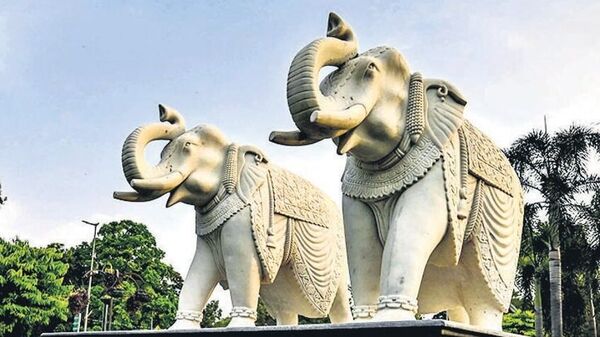
Elephant sculptures built for G20 India, 2023
sectors, including hospitality and tourism, may use the elephant as a symbol to convey a sense of strength, tradition, and reliability. The elephant is often used as a symbol in campaigns and initiatives aimed at raising awareness about wildlife conservation and the protection of endangered species. This serves as a reminder of the importance of preserving the natural habitats of elephants and other wildlife.
The elephant is also a part of the official emblem of the Government of India. The emblem features an adaptation of the Lion Capital of Ashoka, with four lions back-to-back. The base of the emblem is supported by a galloping horse and a bull, with an elephant on the other side. This emblem is used on official documents, government buildings, and currency. The elephant is used as a symbol by various political parties in India. For example, the Bahujan Samaj Party (BSP), a political party in India, has an elephant as its symbol. This choice is often linked to the party’s focus on social justice and empowerment.
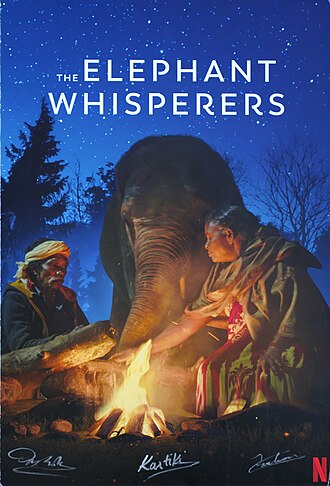
Netflix poster for The Elephant Whisperer
The symbolism of Elephant is also found in modern art mediums such as cinema. We can see an example of this in the 2022 Indian documentary The Elephant Whisperers. The documentary tells the story of the relationship that grows between a couple and Raghu, an abandoned young elephant placed in their care. It defeated other nominees including Stranger at the Gate and How do you Measure a Year? to win the 95th Academy Awards’ Best Documentary Short Film. This made it the first Indian film to win an Academy Award in that category.
So we know how important the elephant has been in culture for centuries now. It also thus reminds us to amp up our conservation efforts in order to continue having elephants as a proud display of our glorious past.
Reference
- Pradhan, S., & Sumant, S. (2016). Lion and Elephant Motif or Gaja-Simha and the Gajamauktikas.
- Burdhan, A. (2016). Elephant as a Fertility Symbol in Indian Art and Religion.
- Condra, R. (2016). Elephant Motifs on Indian Coins and Their Significance.
- Singh, A. (2016). Elephants in the Mauryan Age: Significance and Symbolism.
- Kadgaonkar, S. B. (2016). An Elephant (Gaja) in Ancient Indian Art-A Preliminary Survey.
- Sankrityayan, N. K. (2016). Association of Elephants with Goddess Lakshmi: Myth, Ritual, and Temples.
Pictures
- Wikimedia
- Wikimedia
- Wikimedia
- Wikimedia
- The Times of India
- IMDB
- April 25, 2024
- 14 Min Read
- April 4, 2024
- 7 Min Read




